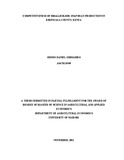| dc.description.abstract | Past studies have indicated that trade in snap beans is highly profitable. However, there is
limited information on costs and how value added benefits are shared by value chain
participants. The objective of this study is to assess the competitiveness of small farmers of
snap beans and to assess how the value-added benefits are shared by various participants of
the snap bean value chain in Kirinyaga County. A random sample of 139 farmers consumers
were interviewed using a semi-structured questionnaire. Focus group discussions and key
informant interviews were also conducted with 10 brokers, 5 transporters, 5 exporters, 5
supermarket stores, 2 processors, 10 local vendors and 100 consumers. The value chain
analysis software developed by FAO was used for financial analysis to capture the share of
value added by each chain participant. One-way ANOVA tests were conducted to compare
the mean value added between the actors in each channel and to determine if any of those
means are significantly different. Levene’s Test of Homogeneity of Variances was used to
test for the suitability of using ANOVA analysis in this study. Four main marketing channels
were identified that comprised domestic (formal and informal markets) and export channels.
Results indicate that no major value addition involving change of form was done by the
players at any level. The existence of formal domestic channels shows that production and
marketing of snap beans that targets the domestic market can be increased. Farmers had the
lowest share of value added among the chain participants. In the formal domestic channel
farmers had a value added share of 15.6% compared with 16.3% for brokers, 30.5% for
retailers and 37.6% for processor, respectively. The mean value added for the chain actors
were statistically significantly different in all the four channels. Multiple comparisons using
Tukey post-hoc test further showed that all means, except between farmers and brokers, were
different. Shorter chains where brokers were excluded provided farmers higher benefits than
longer chains. In spite of this lower share of value added by farmers, the study finds that the
small farmers were still competitive and that the entire chain was profitable in all the four
channels that were analyzed. The study recommends that while the Government should have
policy interventions that seek to reduce the number of market intermediaries in the chains,
farmers should also consider venturing into value addition practices such as trimming and
packaging their beans for the local supermarkets. It further recommends that farmers should
sell through exporters as this channel offers them more benefits. The results would provide
exporters, researchers and government officials with additional information in formulating
policies which will enhance export competitiveness of Kenya’s smallholder snap beans
production. | en |

